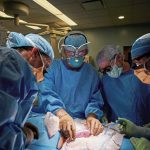A team of surgeons in New York reached a milestone last month in transplant medicine: A kidney from a pig attached to a human patient wasn’t immediately rejected — and the organ appeared to function normally. Announced this week, the procedure was performed at New York University’s Langone Transplant Institute.
The Pittsburgh connections to the breakthrough start with the animal itself. The kidney came from a genetically modified pig that is a blood relative of a group of pigs developed by a transplant team at UPMC in the 1990s.
That team was responsible for early achievements in the field. Headed by the late Dr. Thomas Starzl and Dr. John Fung, the UPMC team performed the first successful animal-to-human transplant in 1992 using a kidney from a baboon. The 35-year-old patient who received the baboon liver lived another 70 days, but the surgery was considered an important step in helping to prevent organ rejection.
Fung now serves as chief of transplant surgery at the University of Chicago Medical Center. In a telephone interview Wednesday morning, he said that while much still needs to be done to determine the long-term results of the pig-to-human kidney transplant, the success by the team in New York “is very, very exciting.”
“I’ve been speaking with members of the transplant team in New York so I knew this was coming down the pike,” he said.
“The pigs that were used are from the same blood line as the ones we developed in Pittsburgh because we kind of predicted back then that these genetic modifications would make the barrier risk for rejection (of organs) slower,” he said.
Dr. Robert Montgomery, who leads the NYU transplant team, said the fact that the organ functioned outside the body is a strong indication that it will work if one is placed inside a body.
“It was better than I think we even expected,” he said in a New York Times article. “It just looked like any transplant I’ve ever done from a living donor. A lot of kidneys from deceased people don’t work right away, and take days or weeks to start. This worked immediately.”
While much of the early animal-to-human transplant research involved primates, using pigs has become advantageous because they have large litters, reach adult size quickly and have organs comparable to humans.
Pig heart valves also have been used successfully for decades in humans. The blood thinner heparin is derived from pig intestines. Pig skin grafts are used on burns and Chinese surgeons have used pig corneas to restore sight.
Researchers have long looked for ways to grow livers, hearts and other organs in animals to create a stream of organs for the nearly 107,000 people in the United States who are on a transplant waiting list, according the non-profit American Transplant Foundation.
About 12 people die each day waiting for an organ.
Fung said once the data has been collected and analyzed from the pig-to-human transplant, the next logical step will be to track the long-term success of the surgery.
He noted that even though the pig kidney was attached outside the brain-dead patient’s body — to blood vessels in the patient’s upper leg — the fact that the organ was not immediately rejected and is functioning is the most critical component of the experiment’s results. He called it a positive sign for future research.
“I think the next logical step will be to transplant a pig kidney inside a human,” he said. “And I expect we’ll see a lot of fine-tuning with other genetic modifications as they try to make the organs less pig-like and more human-like.
“Our team in Pittsburgh envisioned this happening, but we really have to give credit to Dr. (Robert) Montgomery and his team in New York for moving the field forward.”











